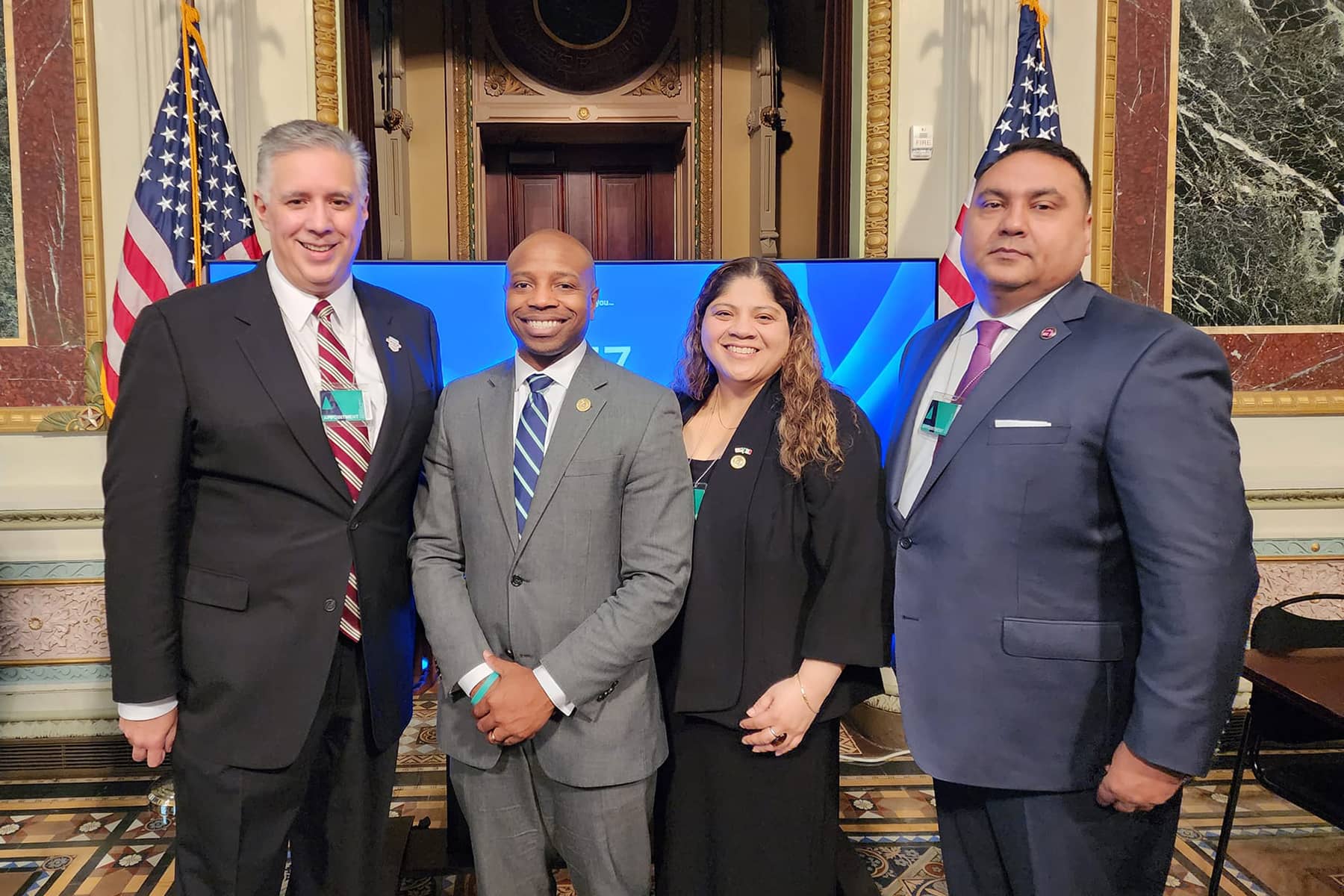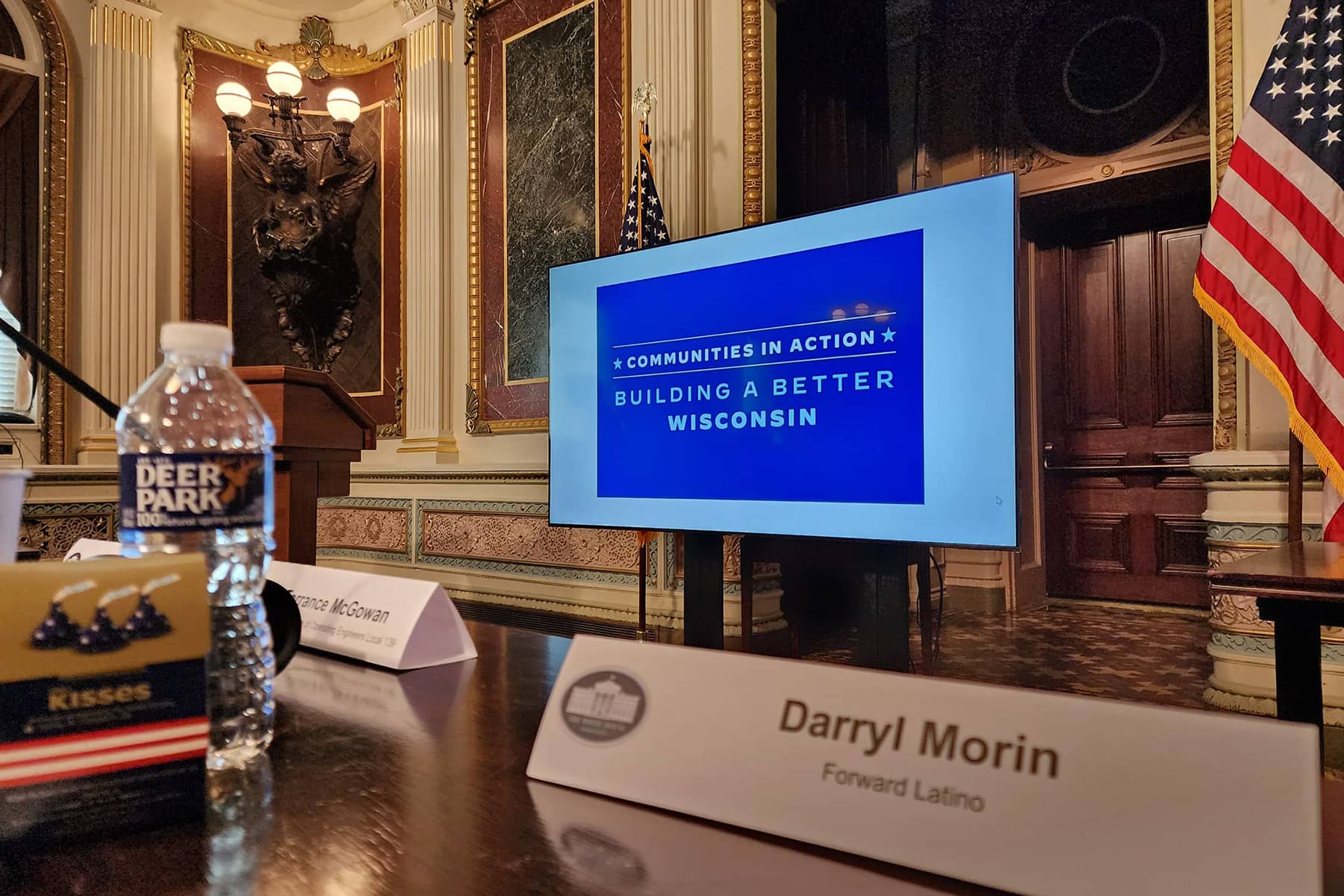
As National President of Forward Latino headquartered in Franklin, Wisconsin, I received an invitation to attend an event at the White House. The day was called “Communities in Action: Building A Better Wisconsin.”
The invitation stated that the day would include remarks and discussions with Senior Biden-Harris Administration officials on pressing issues in Wisconsin. The only request beyond that of our attendance was to be prepared to share priorities in our community and comments on how the policies put and place and legislation signed into law by this president have impacted Wisconsin.
Upon arriving at the White House security post, I saw Milwaukee Mayor Cavalier “Chevy” Johnson accompanied by Patricia Cantu-Ruiz of the City of Milwaukee’s Department of Administration. As we worked our way through security and where escorted to our meeting room, I saw many others I knew including Ed Garza, President of Milwaukee’s Center for Veteran’s Issues; Gene Manzanet, newly appointed Senior Director of Diverse Business Development of the Wisconsin Economic Development Corporation; Wisconsin Senate Minority Leader Melissa Agaard; Joel Brennan, President of the Greater Milwaukee Committee; and Nick Matuszewski, Policy Associate from the Wisconsin Anti-Violence Effort Education Fund among them.
In full transparency, as I have been advocating for Latino issues on the local, regional, and national level for over 15 years, I have been invited and participated in policy discussions at the White House by both President George W. Bush and President Barack Obama Administrations. I will only add that while both those administrations advanced diversity when compared to their predecessors, never have I seen such diverse representation of individuals across the White House Campus.
As a representative who advocates for the Hispanic community, my focus is on Hispanic representation. This administration has numerous Hispanics serving in the U.S. Cabinet, as well as agency administrators. I have also met with Hispanics serving on the Biden Domestic Policy Council, and with individuals serving on the National Security Council, in White House communications, the office of public engagement. and more. This extends to members of the President’s Senior Advisors and the Vice President’s personal staff.
I highlight this because representation matters. These individuals understand concerns not just at the legal level, but from a experience and cultural perspective. Not only does this allow for a deeper understanding, but it allows the dialogue to begin at a more advanced stage, allowing for greater progress.
My day at the White House began with introductions and then briefings, followed by a discussion with Senior Biden-Harris officials. This included Julie Chavez Rodriguez, Sr. Advisor to the President, Secretary Tom Vilsack of the United States Department of Agriculture, American Rescue Plan Coordinator and Senior Advisor to the President Gene Sperling, John Podesta, Senior Advisor to the President for Clean Energy and Domestic Policy Director and Sr. Advisor to the President on Domestic Policy Ambassador Susan Rice.
As expected, each official touted examples of the benefits Wisconsin has received due to the 300 plus pieces of bipartisan legislation signed into law by President Biden. However, what was not expected, was the detail provided on why legislation such as the American Rescue Plan Act was crafted the way it was, and the emphasis behind its main components.
During this detailed discussion, an analysis was shared that they had done on previous governmental responses to severe economic crises. It was then explained how the challenge they faced was compounded as the nation was not only suffering an economic crisis, but that it was brought on by a public health emergency. As such, the risk of both the short-term and long-term damage to our country was much greater if not managed properly.
While we heard an abundance of facts and statistics underscoring various pieces of the American Rescue Plan Act and others, perhaps the most impactful portion of the discussion focused on a condition that Gene Sperling labeled “scarring.” After looking at previous governmental responses to economic crises, he sited staggering statistics focused on individuals who could not find employment over varying lengths of time following an economic crisis, the impact it had on their credit, number of evictions, home foreclosures, and bankruptcies. Lastly, he shared the number of those who were never able to fully recover from the financial and emotional “scarring” that occurred – for no fault of their own, but as a result of the conditions created by the economic crisis.
As such, there was great emphasis placed on supporting both businesses, individuals, and families, to ensure they made it through the pandemic with as little of the scarring as possible. From the Payroll Protection Program, eviction and foreclosure moratoriums, to the advanced child tax credits that sent checks to eligible families lifting over 30% of children out of poverty, to the dramatic increase in Supplemental Nutrition Assistance Program (SNAP) funding, these were all efforts to ensure support for the well-being of the American people.
At that point they reminded us that the Biden-Harris administration not only led us through the pandemic – and the public health and financial challenges it created, but signed into law the Promise to Address Comprehensive Toxics (PACT) Act, the Infrastructure Investment and Jobs Act, the Chips and Science Act, the Inflation Reduction Act and more. All done in only two years, the President’s and Vice President’s first two years in office. These efforts resulted in more Veterans receiving benefits and service than ever before in our nation’s history, billions of dollars for Wisconsin to fix our roads and bridges, replace lead water pipes in our homes and schools, address supply chain issues, improve national security, and cap out-of-pocket insulin expenses for seniors to no more than $35 a month – and $2,000 per year for prescription medications, respectively.
The discussion then turned to plans moving forward. Plans designed to build upon the historic progress made in these first two years, which includes historically low unemployment rates, more than 12 million jobs created in just two years, more than in any other presidency in U.S. history, as well as in number of new businesses created.
They detailed plans to further reduce inflation brought about by our nation’s over-reliance on foreign manufacturing, and the supply chain challenges that were created by the pandemic and the spike in energy and food costs created by Russia’s invasion of Ukraine. This was followed by detailed discussion on crime and gun violence prevention, climate change and renewable energy, workforce development and education, student debt, immigration, and more. While I was aware of much of the work being done in these areas, I was struck by the remarks made by USDA Secretary Tom Vilsack.
He was intimately aware of the challenges Wisconsin’s family farms and dairies are facing. He went into great detail about the investments the USDA was making to support Wisconsin’s family farms and dairies, as well as those throughout the country. Among the most stunning was the fact he shared regarding the current state of farming in the United States. While last year American farmers exported more than in any other year in U.S. history – with exports topping $196 billion in exports, almost half of all family farms had negative farm income. They were reliant on second jobs and other forms off-farm income to be able to and pay their bills.
As such, he discussed USDA initiatives and investments being made to elevate family farm and dairy profitability. This includes billions of dollars in USDA grants to small and mid-sized farms to offset the cost of transitioning to “Climate-Smart Commodities.” A climate-smart commodity is any agricultural commodity that is produced using agricultural (farming, ranching, or forestry) practices that reduce greenhouse gas emissions or sequester carbon. Products grown using these methods are not only better for our environment, but garnering higher prices as the public’s demand for such products continues to grow.
The secretary also highlighted investments the department is making to expedite the conversion of farm byproducts – currently being overused to fertilize farmland and making its way into water sources and elsewhere – into jet fuel. This will improve the quality of the soil on the farm, protect our water sources, and create a new source of revenue for farms. But it will also provide airlines with a jet fuel that will burns much cleaner and reduce dependence on high carbon producing fossil fuels.
Attendees were then invited to share stories of their work and success in Wisconsin using some of the President’s initiatives. On behalf of Forward Latino, I shared information on our “Por Mi Familia, I got Vaccinated” campaign, the largest ever Spanish-language public health campaign done by a non-profit in our state’s history.
I also shared stories from our members, affiliates, and partners on subjects ranging from the importance of the President’s continued defense of the Deferred Action Childhood Arrival (DACA) program, to the benefits of his efforts to address Health Equity – which has allowed more than 220,000 people in Wisconsin to enroll and take advantage of the benefits of the Affordable Care Act (ACA), to the progress being made workforce development benefitting Latinos, and how his policies have led to an explosion of Hispanic-owned small businesses.
After a series of smaller meetings, we then took a group photograph. I ended the day giving interviews on the front lawn of the White House. While it began to rain as I walked out the front gate of the White House, the day had left me with a sunny and optimistic view of the administration’s plan to “Build A Better Wisconsin.”
Darryl Morin
Darryl Morin















